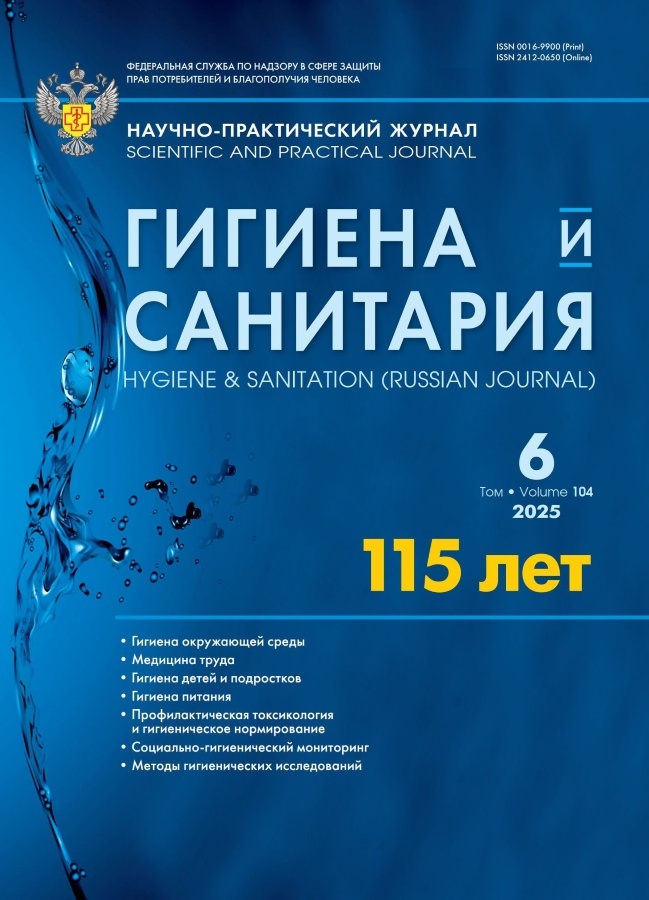Современные подходы к донозологической диагностике и коррекции экологически обусловленного стресса у детей и подростков
- Авторы: Сетко Н.П.1, Жданова О.М.1, Сетко А.Г.2, Лукьянов С.Э.1
-
Учреждения:
- ФГБОУ ВО «Оренбургский государственный медицинский университет» Минздрава России
- ФБУН «Федеральный научный центр гигиены имени Ф.Ф. Эрисмана» Роспотребнадзора
- Выпуск: Том 104, № 6 (2025)
- Страницы: 741-749
- Раздел: ГИГИЕНА ДЕТЕЙ И ПОДРОСТКОВ
- Статья опубликована: 15.12.2025
- URL: https://modernonco.orscience.ru/0016-9900/article/view/691563
- DOI: https://doi.org/10.47470/0016-9900-2025-104-6-741-749
- EDN: https://elibrary.ru/aekqvv
- ID: 691563
Цитировать
Полный текст
Аннотация
Об авторах
Нина Павловна Сетко
ФГБОУ ВО «Оренбургский государственный медицинский университет» Минздрава России
Email: K_epidem.fpdo@orgma.ru
ORCID iD: 0000-0002-8073-0614
Олеся Михайловна Жданова
ФГБОУ ВО «Оренбургский государственный медицинский университет» Минздрава России
Email: Robokors@yandex.ru
ORCID iD: 0000-0003-4694-0674
Андрей Геннадьевич Сетко
ФБУН «Федеральный научный центр гигиены имени Ф.Ф. Эрисмана» Роспотребнадзора
Email: a_isetko@mail.ru
ORCID iD: 0000-0002-9724-8672
Сергей Эдуардович Лукьянов
ФГБОУ ВО «Оренбургский государственный медицинский университет» Минздрава России
Email: c_luk_10@mail.ru
ORCID iD: 0000-0003-3369-2886
Список литературы
-
Казымова Г.С. Факторы, вызывающие стресс у школьников и методы его устранения. International Journal of Medicine and Psychology. 2023; 6(8): 188–91. https://elibrary.ru/burdrk Кочетова Ю.Ю., Старчикова М.В., Бендрикова А.Ю., Репкина Т.В. Оценка значимости факторов стресса, нерационального питания и низкой физической активности для здоровья школьников. Science for Education Today. 2020; 10(5): 211–25. https://doi.org/10.15293/2658-6762.2005.12 https://elibrary.ru/udmkol Сетко Н.П., Жданова О.М., Лукьянов С.Э., Мокеева М.М., Бейлина Е.Б., Закурдаева Е.А. и др. К вопросу формирования тревожности среди учащихся начального звена и её профилактики в условиях современного образовательного процесса. Оренбургский медицинский вестник. 2024; 12(1): 56–62. https://elibrary.ru/fnzexz Сетко А.Г., Терехова Е.А., Жданова О.М., Лукьянов В.П. Особенности социально-психологической адаптации учащихся различных типов общеобразовательных учреждений. Оренбургский медицинский вестник. 2021; 9(1): 66–70. https://elibrary.ru/wxmdqo Штина И.Е., Зенина М.Т., Валина С.Л., Устинова О.Ю., Лужецкий К.П. Особенности тиреоидного статуса у учащихся с различной напряженностью образовательного процесса. Здоровье населения и среда обитания – ЗНиСО. 2018; 26(9): 33–8. https://doi.org/10.35627/2219-5238/2018-306-9-33-38 https://elibrary.ru/vagmza Барг А.О., Кобякова О.А., Лебедева-Несевря Н.А. Оценка связи тревожности и заболеваемости у учащихся среднего и старшего возраста. Гигиена и санитария. 2020; 99(8): 829–33. https://doi.org/10.47470/0016-9900-2020-99-8-829-833 https://elibrary.ru/ehgywd Quattlebaum M., Kipp C., Wilson D.K., Sweeney A., Loncar H., Brown A., et al. A qualitative study of stress and coping to inform the LEADS Health Promotion Trial for african american adolescents with overweight and obesity. Nutrients. 2021; 13(7): 2247. https://doi.org/10.3390/nu13072247 Nagabharana T.K., Joseph S., Rizwana A., Krishna M., Barker M., Fall C., et al. What stresses adolescents? A qualitative study on perceptions of stress, stressors and coping mechanisms among urban adolescents in India. Wellcome Open Res. 2021; 6: 106. https://doi.org/10.12688/wellcomeopenres.16818.1 Leonard N.R., Gwadz M.V., Ritchie A., Linick J.L., Cleland C.M., Elliott L., et al. A multi-method exploratory study of stress, coping, and substance use among high school youth in private schools. Front. Psychol. 2015; 6: 1028. https://doi.org/10.3389/fpsyg.2015.01028 Hörbo M., Johansson C., Garnow T., Garmy P., Einberg E.L. Experiences of stress – a focus group interview study among Swedish adolescents during the COVID-19 pandemic. J. Sch. Nurs. 2023; 39(2): 189–97. https://doi.org/10.1177/10598405211071002 Hosseinkhani Z., Nedjat S., Hassanabadi H.R., Parsaeian M. Academic stress from the viewpoint of Iranian adolescents: A qualitative study. J. Educ. Health Promot. 2019; 8: 13. https://doi.org/10.4103/jehp.jehp_202_18 Låftman S.B., Almquist Y.B., Östberg V. Students’ accounts of school-performance stress: a qualitative analysis of a high-achieving setting in Stockholm, Sweden. J. Youth Stud. 2013; 16(7): 932–49. https://doi.org/10.1080/13676261.2013.780126 Koss K.J., Gunnar M.R. Annual research review: early adversity, the hypothalamic-pituitary-adrenocortical axis, and child psychopathology. J. Child Psychol. Psychiatry. 2018; 59(4): 327–46. https://doi.org/10.1111/jcpp.12784 Compas B.E., Jaser S.S., Bettis A.H., Watson K.H., Gruhn M.A., Dunbar J.P., et al. Coping, emotion regulation, and psychopathology in childhood and adolescence: A meta-analysis and narrative review. Psychol. Bull. 2017; 143(9): 939–91. https://doi.org/10.1037/bul0000110 Куприянов Р.В., Кузьмина Ю.М. Психодиагностика стресса: практикум. Казань; 2012. Romeo R.D. The impact of stress on the structure of the adolescent brain: implications for adolescent mental health. Brain Res. 2017; 1654: 185–91. https://doi.org/10.1016/j.brainres.2016.03.021 Low N.C.P., Dugas E., O’Loughlin E., Rodriguez D., Contreras G., Chaiton M., et al. Common stressful life events and difficulties are associated with mental health symptoms and substance use in young adolescents. BMC Psychiatry. 2012; 12(1): 1–10. https://doi.org/10.1186/1471-244X-12-116 O’Connor D.B., Thayer J.F., Vedhara K. Stress and health: A review of psychobiological processes. Annu. Rev. Psychol. 2021; 72: 663–88. https://doi.org/10.1146/annurev-psych-062520-122331 Li H., Arimi F.M.L., Mahadir A., Xie M., He Z.L. The prevalence and its associated factors of psychological stress among middle school students in China: pooled evidence from a systematic scoping review. Front. Public Health. 2024; 12: 1358210. https://doi.org/10.3389/fpubh.2024.1358210 Pascoe M.C., Hetrick S.E., Parker A.G. The impact of stress on students in secondary school and higher education. Int. J. Adolesc. Youth. 2020; 25(1): 104–12. https://doi.org/10.1080/02673843.2019.1596823. Lagraauw H.M., Kuiper J., Bot I. Acute and chronic psychological stress as risk factors for cardiovascular disease: insights gained from epidemiological, clinical and experimental studies. Brain Behav. Immun. 2015; 50: 18–30. https://doi.org/10.1016/j.bbi.2015.08.007
Дополнительные файлы









